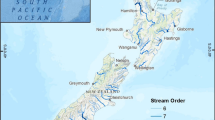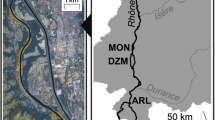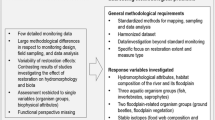Abstract
River restoration is a main emphasis of river management in European countries. Cross-national comparisons of its implementation are still rare in scientific literature. Based on French and German national censuses, this study compares river restoration practices and monitoring by analysing 102 French and 270 German projects. This comparison aims to draw a spatial and temporal framework of restoration practices in both countries to identify potential drivers of cross-national similarities and differences. The results underline four major trends: (1) a lag of almost 15 years in river restoration implementation between France and Germany, with a consequently higher share of projects in Germany than in France, (2) substantial similarities in restored reach characteristics, short reach length, small rivers, and in “agricultural” areas, (3) good correspondences between stressors identified and restoration measures implemented. Morphological alterations were the most important highlighted stressors. River morphology enhancement, especially instream enhancements, were the most frequently implemented restoration measures. Some differences exist in specific restoration practices, as river continuity restoration were most frequently implemented in French projects, while large wood introduction or channel re-braiding were most frequently implemented in German projects, and (4) some quantitative and qualitative differences in monitoring practices and a significant lack of project monitoring, especially in Germany compared to France. These similarities and differences between Germany and France in restoration application and monitoring possibly result from a complex set of drivers that might be difficult to untangle (e.g., environmental, technical, political, cultural).







Similar content being viewed by others
References
Arnaud F, Piégay H, Schmitt L, Rollet AJ, Ferrier V, Béal D (2015) Historical geomorphic analysis (1932–2011) of a by-passed river reach in process-based restoration perspectives: The Old Rhine downstream of the Kembs diversion dam (France, Germany). Geomorphology 236:163–177
Auerbach DA, Deisenroth DB, McShane RR, McCluney KE, LeRoy Poff N (2014) Beyond the concrete: Accounting for ecosystem services from free-flowing rivers. Ecosyst Serv 10:1–5
Baron JS, LeRoy Poff N, Angermeier PL, Dahm CN, Gleick PH, Hairston NG, Jackson RB, Johnston CA, Richter BD, Steinman AD (2002) Meeting ecological and societal needs for freshwater. Ecol Appl 12(5):1247–1260
Bednarek AT (2001) Undamming rivers: A review of the ecological impacts of dam removal. Environ Manage 27(6):803–814
Bernhardt ES, Palmer MA (2011) River restoration - the fuzzy logic of repairing reaches to reverse watershed scale degradation. Ecol Appl 21:1926–1931
Bernhardt ES, Palmer MA, Allan JD, Abell R, Alexander G, Brooks S, Carr J, Clayton S, Dahm C, Follstad Shah J, Galat DL, Gloss S, Goodwin P, Hart DH, Hassett B, Jenkinson R, Katz S, Kondolf GM, Lake PS, Lave R, Meyer JL, O’Donnell TK, Pagano L, Sudduth E (2005) Synthesizing US river restoration efforts. Science 308:636–637
Birk S, Bonne W, Borja A, Brucet S, Courrat A, Poikane S, Solimini A, van de Bund W, Zampoukas N, Hering D (2012) Three hundred ways to assess Europe’s surface waters: An almost complete overview of biological methods to implement the water framework directive. Ecol Indic 18:31–41
BMUB/UBA (2013) Water resource management in Germany. Part 1 fundamentals and part 2 water quality. Federal Ministry for the Environment, Nature Conservation and Nuclear Safety and Federal Environment Agency (BMUB), Umweltbundesamt (UBA), Dessau-Roßlau, Germany
Boon PJ, Calow P, Petts GE (1992) River conservation and management. John Wiley & Sons Ltd, Chichester, UK
Boon PJ, Raven PJ (2012) River conservation and management. John Wiley & Sons Ltd, Chichester, UK
Boyer M, Piégay H, Ruffinoni C, Citterio A, Bourgery C, Caillebote P (1998) Guide technique n°1. La gestion des boisements de rivières. Agence de l’Eau Rhône-Méditerranée Corse (RMC WA) (French language)
Brookes A, Gregory KJ, Dawson FH (1983) An assessment of river channelization in England and Wales. Sci Total Environ 27:97–111
Cans R (1997) « Les trois sœurs de l’écologie », In Besse JM, Roussel I, Environnement: représentations et concepts de la nature, L’Harmattan Edition (French language)
Caro C (2009) Le développement de la conscience environnementale et l’émergence de l’écologie politique dans l’espace public en France et en Allemagne, 1960-1990. PhD Thesis, Université Paris III / Technische Universität Dresden (French language)
Clark MJ (2002) Dealing with uncertainty: adaptive approaches to sustainable river management. Aquat Conserv Mar Freshw Ecosyst 12:347–363
Combroux ICS, Bornette G, Amoros C (2002) Plant regenerative strategies after a major disturbance: the case of a riverine wetland restoration. Wetlands 22(2):234–246
Cottet M, Piégay H, Bornette G (2013) Does human perception of wetland aesthetics and health relate to ecological functioning? J Environ Manage 128:1012–1022
Davis MA, Slobodkin LB (2004) The science and values of restoration ecology. Restor Ecol 12:1–3
Dudgeon D, Arthington AH, Gessner MO, Kawabata ZI, Knowler DJ, Lévêque C, Naiman RJ, Prieur-Richard AH, Soto D, Stiassny MLJ, Sullivan CA (2005) Freshwater biodiversity: importance, threats, status and conservation challenges. Biol Rev 81:163–182
Dufour S, Piégay H (2009) From the myth of a lost paradise to targeted river restoration: forget natural references and focus on human benefits. River Res Appl 25:568–581
Dunn H (2004) Defining the ecological values of rivers: the views of Australian river scientists and managers. Aquat Conserv Mar Freshw Ecosyst 14:413–433
EC (1982) The European and their environment. Eurobarometer, Commission of the European Communities (EC). Brussels, Belgium
EEA (2007). Corine Land Cover 2006 technical guidelines. European Environment Agency (EEA) Technical report, 17/2007. Copenhagen, Denmark
EEA (2012a) Catchments and Rivers Network System ECRINS v1.1. Rationales, building and improving for widening uses to Water Accounts and WISE applications. European Environment Agency (EEA) Technical report, 7/2012. Copenhagen, Denmark
EEA (2012b) European waters - assessment of status and pressures. European Environment Agency (EEA) Report, 8/2012. Copenhagen, Denmark
EEA (2016) WISE WFD database, published 12/11/2012, last modified 15/08/2016, European Environment Agency (EEA). http://www.eea.europa.eu
Everard M (2012) Why does ‘good ecological status’ matter? Water Environ J 26(2):165–174
Forget G, Bernez I (2011) Assessment of the success of headwater restoration through the vegetation diversity analysis of four Oir river’s tributaries (Normandy, France). Procedia. Environ Sci 9:47–53
Friberg N, Bonada N, Bradley DC, Dunbar MJ, Edwards FK, Grey J, Hayes RB, Hildrew AG, Lamouroux N, Trimmer M, Woodward G (2011) Biomonitoring of human impacts in freshwater ecosystems: the goof, the bad and the ugly. In: Woodward G (ed) Advances in ecological research, 44. Academic press, Amsterdam, p 1–68
Fryirs K, Brierley GJ (2009) Naturalness and place in river rehabilitation. Ecol Soc 14(1):20
Garcia de Jalón D, Alonso C, González del Tanago M, Martinez V, Gurnell A, Lorenz S, Wolter C, Rinaldi M, Belletti B, Mosselman E, Hendriks D, Geerling G (2013) Effects of pressures on hydromorphology. REFORM Delivrable, D1.2
González del Tánago M, García de Jalón D, Román M (2012) River restoration in Spain: Theoretical and practical approach in the context of the European water framework directive. Environ Manage 50:123–139
González del Tánago M, Martínez-Fernández V, García de Jalón D (2016) Diagnosing problems produced by flow regulation and other disturbances in Southern European rivers: the Porma and Curuenõ Rivers (Duero Basin, NW Spain). Aquat Sci 78:121–133
Gore JA (1985) The restoration of rivers and streams. Theories and experience. Butterworth Publishers, Boston, USA
Gore JA, Petts GE, (1989) Alternatives in regulated river management. Inc.CRC Press Inc., Boca Raton, USA
Gregory KJ (2006) The human role in changing river channels. Geomorphology 79:172–191
Grisoni A, Sierra R (2013) Écologie ou Umwelt? Une revue historiographique des engagements écologistes et environnementalistes en France et en Allemagne. Revue de l’IFHA, Online, 5 (French language)
Groombridge B, Jenkins M (1998) Freshwater biodiversity: a preliminary global assessment. United Nations Environment Programme, World Conservation Monitoring Centre Biodiversity Series No. 8, WCMC - World Conservation Press, Cambridge, UK
Henry CP, Amoros C (1995) Restoration ecology of riverine wetlands. 1. A scientific base. Environ Manage 19(6):891–902
Henry CP, Amoros C, Giuliani Y (1995) Restoration ecology of riverine wetlands: II. An example in a former channel of the Rhone river. Environ Manage 19(6):903–913
Hering D, Borja A, Carstensen J, Carvalho L, Elliott M, Feld CK, Heiskanen AS, Johnson RK, Moe J, Pont D, Solheim AL, van de Bund W (2010) The European water framework directive at the age of 10: A critical review of the achievements with recommendations for the future. Sci Total Environ 408:4007–4019
Husson F, Josse J, Pagès J (2010) Principal component methods - hierarchical clustering - partitional clustering: why would we need to choose for visualizing data? Technical Report – Agrocampus. Applied Mathematics Department, September 2010. Rennes, France
Jähnig SC, Lorenz AW, Hering D (2009) Restoration effort, habitat mosaics, and macroinvertebrates - does channel form determine community composition? Aquat Conserv Mar Freshw Ecosyst 19(2):157–169
Jähnig SC, Lorenz AW, Hering D, Antons C, Sundermann A, Jedicke E, Haase P (2011) River restoration success: a question of perception. Ecol Appl 21(6):2007–2015
Kail J, Hering D, Muhar S, Gerhard M, Preis S (2007) The use of large wood in stream restoration: experiences from 50 projects in Germany and Austria. J Appl Ecol 44(6):1145–1155
Kail J, Brabec K, Poppe M, Januschke K (2015) The effect of river restoration on fish, macroinvertebrates and aquatic macrophytes: A meta-analysis. Ecol Indic 58:311–321
Kail J, Wolter C (2010) Analysis and evaluation of large-scale river restoration planning in Germany to better link river research and management. River Res Appl 27:985–999
Kallis G, Butler D (2001) The EU water framework directive: measures and implications. Water Policy 3(2):125–142
Kern K (1992) Rehabilitation of streams in south-west Germany. In: Boon PJ, Calow P, Petts GE (ed) River conservation and management. John Wiley & Sons Ltd, Chichester, UK, p 321–335
Kondolf GM (1998) Lessons learned from river restoration projects in California. Aquatic Conserv Mar Freshw Ecosyst 8:39–52
Kondolf GM, Yang CN (2008) Planning river restoration projects: social and cultural dimensions. In: Darby S, Sear D (ed) River restoration: Managing the uncertainty in restoring physical habitat. John Wiley & Sons Ltd, Chichester, UK, p 43–60
Kristensen EA, Kronvang B, Wiberg-Larsen P, Thodsen H, Nielsen C, Amor E, Friberg N, Pedersen ML, Baattrup-Pedersen A (2014) 10 years after the largest river restoration project in Europe: Hydromorphological changes on multiple scales in River Skjern. Ecol Eng 66:141–149
Lamouroux N, Gore JA, Lepori F, Statzner B (2015) The ecological restoration of large rivers needs science-based, predictive tools meeting public expectations: an overview of the Rhône project. Freshw Biol 60:1069–1084
Langhans SD, Gessner J, Hermoso V, Wolter C (2016) Coupling systematic planning and expert judgement enhances the efficiency of river restoration. Sci Total Environ 560-561:266–273
Latapie A, Camenen B, Rodrigues S, Paquier A, Bouchard JP, Moatar F (2014) Assessing channel response of a long river influenced by human disturbance. Catena 121:1–12
Le Lay YF, Piégay H, Gregory K, Chin A, Dolédec S, Elosegi A, Mutz M, Wyżga B, Zawiejska J (2008) Variations in cross-cultural perception of riverscapes in relation to in-channel wood. Trans Inst of Br Geogr 33:268–287
Le S, Josse J, Husson F (2008). FactoMineR: An R Package for Multivariate Analysis. J Stat Softw 25(1):1–18
Lorenz AW, Jähnig SC, Hering D (2009) Re-meandering German lowland streams: Qualitative and quantitative effects of restoration measures on hydromorphology and macroinvertebrates. Environ Manage 44:745–754
Lüderitz V, Jüpner R, Müller S, Feld CK (2004) Renaturalization of streams and rivers – the special importance of integrated ecological methods in measurement of success. An example from Saxony-Anhalt (Germany). Limnologica 34:249–263
Malavoi JR, Souchon Y (2010) Construire le retour d’expérience des opérations de restauration hydromorphologique. Eléments pour une harmonisation des concepts et des méthodes de suivi scientifique minimal. Volets hydromorphologie - hydroécologie. ONEMA (French language)
Matthews J, Reeze B, Feld C, Hendriks A (2010) Lessons from practice: assessing early progress and success in river rehabilitation. Hydrobiologia 655:1–14
MEA (2005) Millennium ecosystem assessment. Ecosystem and human well-being: wetlands and water synthesis. World Resources Institute, Washington, DC, p 80
Morandi B (2014) River restoration in France and worldwide: from the definition of a concept to the practical evaluation of projects. Applicable research elements. PhD Thesis, Université de Lyon, (French language)
Morandi B, Piégay H (2011) River restoration experiences on the web: operational outcomes and perspectives. Nat Sci Soc 19:224–235. (French language)
Morandi B, Piégay H, Lamouroux N, Vaudor L (2014) How is success or failure in river restoration projects evaluated? Feedback from French restoration projects. J Environ Manage 137:178–188
Morandi B, Piégay H, Johnstone K, Miralles D (2016) Les Agences de l’eau et la restauration: 50 ans de tension entre hydraulique et écologique. Vertigo, 16-1 (French language)
Nakamura K, Tockner K, Amano K, 2006. River and wetland restoration: lessons from Japan. Bioscience 56:419–429
ONEMA (2011a) Towards the restoration of rivers and aquatic environments - A collection of river hydromorphology restoration examples, Office National de l’Eau et des Milieux Aquatiques (ONEMA), Agences de l’Eau (WA). Vincennes, France
ONEMA (2011b) Why is it needed to restore river continuity?, Office National de l’Eau et des Milieux Aquatiques (ONEMA). Vincennes, France
Ormerod SJ (2004) A golden age of river restoration science? Aquat Conserv Mar Freshw Ecosyst 14:543–550
Oss M, Maiolini B (2008) La riqualificazione fluviale in trentino: analisi degli interventi effettuati dal 1990 al 2006. Riqualificazione Fluviale 0:30–33. (Italian language)
Paetzold A, Warren PH, Maltby LL (2010) A framework for assessing ecological quality based on ecosystem services. Ecol Complex 7(3):273–281
Pahl-Wostl C (2006) The importance of social learning in restoring the multifunctionality of rivers and floodplains. Ecol Soc 11(1):10
Palmer MA, Bernhardt ES (2006) Hydroecology and river restoration: ripe for research and synthesis. Water Resour Res 42(3):1–4
Palmer MA, Menninger HL, Bernhardt ES (2010) River restoration, habitat heterogeneity and biodiversity: a failure of theory or practice? Freshw Biol 55(S1):205–222
Patt H, Jürging P, Kraus W (1998) Naturnaher Wasserbau. Entwicklung und Gestaltung von Fließgewässern. Springer-Verlag, Berlin Heidelberg, (German language)
Piegay H, Gregory KJ, Bondarev V, Chin A, Dahlstrom N, Elosegi A, Gregory SV, Joshi V, Mutz M, Rinaldi M, Wyzga B, Zawiejska J (2005) Public perception as a barrier to introducing wood in rivers for restoration purposes. Environ Manage 36(5):665–674
Pollard P, Huxham M (1998) The European water framework directive: a new era in the management of aquatic ecosystem health? Aquat Conserv Mar Freshw Ecosyst 8:773–792
R Core Team (2013). R: A language and environment for statistical computing. R Foundation for Statistical Computing, Vienna, Austria
Reich M, Kershner JL, Wildman R (2003) Restoring streams with large wood: A synthesis. Am Fish Soc Symp 37:355–366
Riquier J, Piégay H, Šulc Michalková M (2015) Hydromorphological conditions in eighteen restored floodplain channels of a large river: linking patterns to processes. Freshw Biol 60:1085–1103
RM WA (2011) Portail documentaire de l’Agence de l’eau Rhin-Meuse (online case studies: http://cdi.eau-rhin-meuse.fr/) (French language)
RMC WA (2006) Retour d’expérience d’opérations de restauration de cours d’eau et de leurs annexes, menées sur le bassin RMC. Agence de l’Eau Rhône-Méditerranée & Corse (French language)
Roni P, Beechie T, Pess G, Hanson K (2015) Wood placement in river restoration: fact, fiction, and future direction. Can J Fish Aquat Sci 72:466–478
Roni P, Liermann M, Muhar S, Schmutz S (2012) Monitoring and evaluation of restoration actions. In: Roni P, Beechie T (eds) Stream and watershed restoration: a guide to restoring riverine processes and habitats. Wiley, Chichester, p 254–278
Ruchay D (1995) Living with water: Rhine river basin management. Wat Sci Tech 31(8):27–32
Sarriquet PE, Bordenave P, Marmonier P (2007) Effects of bottom sediment restoration on interstitial habitat characteristics and benthic macroinvertebrate assemblages in a headwater stream. River Res Appl 23:815–828
Shields FD, Cooper CM, Knight SS, Moore MT (2003) Stream corridor restoration research: a long and winding road. Ecol Eng 20:441–454
Souchon Y (2012) Restaurations des cours d’eau. Que nous apprennent les suivis écologiques documentés? ONEMA (French language)
Thomas G, Lorenz AW, Sundermann A, Haase P, Peter A, Stoll S (2015) Fish community responses and the temporal dynamics of recovery following river habitat restorations in Europe. Freshw Sci 34(3):975–990
Toedter A (2012) Charakterisierung und Klassifizierung von Fließgewässer-Revitalisierungsmaßnahmen in Deutschland. Diplomarbeit, Universität Potsdam (German language). Potsdam, Germany
Vörösmarty CJ, McIntyre PB, Gessner MO, Dudgeon D, Prusevich A, Green P, Glidden S, Bunn SE, Sullivan CA, Reidy Liermann C, Davies PM (2010) Global threats to human water security and river biodiversity. Nature 467(7315):555–561
WBA (1989) Flüsse und Bäche: erhalten, entwickeln, gestalten. Wasserwirtschaft in Bayern (WBA), Oberste Baubehörde im Bayerischen Staatsministerium des Innern (German language)
Weber C, Peter A (2001) Success or failure? Do indicator selection and reference setting influence river rehabilitation outcome? North Am. J. Fish Manag 31:535–547
Whiteway SL, Biron PM, Zimmermann A, Venter O, Grant JWA (2010) Do in-stream restoration structures enhance salmonid abundance? A meta-analysis. Can J Fish Aquat Sci 67(5):831–841
Acknowledgements
This study was supported by the IWRM-Net project FORECASTER (German BMBF grant # 02WM1031) and the EU FP7 project REFORM (Grant Agreement No. 282656). The authors acknowledge the French National Agency for Water and Aquatic Environments (ONEMA) for financial and scientific support.
Author information
Authors and Affiliations
Corresponding author
Ethics declarations
Conflict of Interest
The authors declare that they have no competing interests.
Electronic Supplementary Material
Rights and permissions
About this article
Cite this article
Morandi, B., Kail, J., Toedter, A. et al. Diverse Approaches to Implement and Monitor River Restoration: A Comparative Perspective in France and Germany. Environmental Management 60, 931–946 (2017). https://doi.org/10.1007/s00267-017-0923-3
Received:
Accepted:
Published:
Issue Date:
DOI: https://doi.org/10.1007/s00267-017-0923-3




